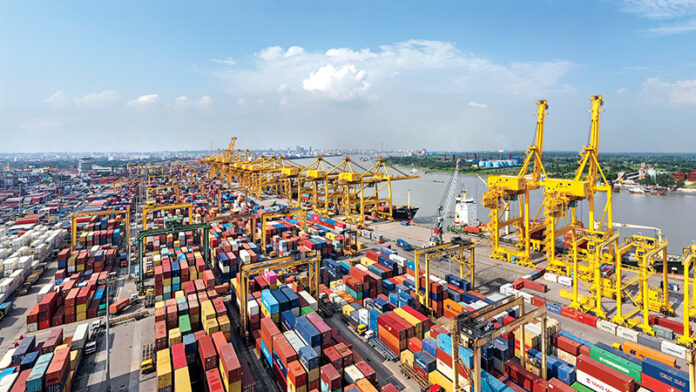Blue Economy refers to the economic activity based on maritime resources. The Bay of Bengal has become the lifeline of the National Economy of Bangladesh. Verdicts by ITLOS and PCA on maritime delimitation with the neighbouring countries resulted in 118,813 sq km, with an extended continental shelf of about 37,000 sq km for Bangladesh. Maritime experts claim that the seabed preserves the region’s vital marine resources for future existence. As primarily anticipated by the seaports, particularly Chittagong Port, as an integrated enterprise to manage the oceans, the sustainability of those conventional and non-conventional resources necessitates epoch-making institutionalised management. The creation of national megaplans like The Delta Plan of 2100, Agenda 2030, and Vision 2041 has made national ports like Chittagong, Mongla, and Payra Ports more advanced in their support of the Blue Economy.
Prologue
The Green Economy strategy obsessed the world to ensure sustainable development before the “Rio +20” United Nations Conference on Sustainable Development (UNCSD), held in Rio de Janeiro, 20–22 June 2012. The colour green represents nature, which keeps the Earth’s ecosystems operating properly and passes on the mechanism to the biosphere. Many coastal nations questioned the Green Economy’s emphasis and relevance. While preparing for Rio+20, there were strong arguments for giving a “Blue Economy” strategy more attention. The Oceans, including the High Seas, a shared cultural legacy of humanity, serve as the final frontier in its pursuit of sustainable development; hence this strategy has broad applicability. Bangladesh’s coastline is 710 km long, stretching from the pristine Sundarbans Mangrove Forest in the southwest to the live coral island of St. Martin’s in the southeast. Three national seaports conduct their operations within this region. Compared to other ports, Chittagong Port is the biggest in operations. The Government of Bangladesh Gazette announcement of 24 January 2019, further increased the seaward limit of Chittagong Port from Sitakunda to Sonadia Island.
Prospects of the Blue Economy in Bangladesh
Ships produce pollutants and other dangerous emissions. However, they also move a lot of essential items across the oceans, and the seaborne trade is still growing. 92% of Bangladesh’s annual trade is carried out through seaborne containers, and the Chittagong Port handles 98% of them. Additionally, the Matarbari deep seaport terminal is being constructed by the Chittagong Port Authority.
Transit passage is being used forone’s freedom of navigation and overflight only to move quickly and continuously from one area of the high seas to another while meeting the entry requirements of that state. Ports can count on currency, allowing cargo containers to pass either innocently or in transit. Therefore, an international port might be developed to be a transit for other nations.
In many developing countries, a maritime activity already serves as a significant source of income and employment, contributing to the reduction of extreme poverty and hunger through activities like the employing seafaring personnel, ship recycling, ship ownership and operation, shipbuilding and repair, and port services. But human development has put a lot of stress on the ability of marine and coastal resources to bounce back. Increasing pollution and unsustainable development along the coast make the loss of biodiversity and the decline of environmental services worse.
Oceans are considered as hydro stations for mining and modern technologies. Important seaborne shipments are moving through the conduits. Notably, climate change threatens to destroy the foundations of large coastal areas where people live and work. As a result, it becomes vulnerable devoid of monitoring and global networking.

Seaports and Blue Economy
The Blue Economy is a developing idea that conceptualises the sustainable use of maritime resources for economic growth, improved livelihoods and jobs, and ocean ecosystem health. The National and International Ports highly influence the global maritime economy. Port has integrated management that serves the essence of sustainable development in marine resources for economic growth. It extends from the hinterland, or inland region lying behind a port, to maritime delimitation. A harbour correlates the hinterland with the maritime economy, etching to the high seas open to all states, coastal or landlocked.

Freedom of the high seas comprises, among other things, both coastal and landlocked states subject to certain conditions:
1. Freedom of navigation
2. Freedom of overflight
3. Freedom to lay submarine cables and pipelines
4. Freedom to construct artificial islands and installations permitted under international law
5. Freedom of fishing
6. Freedom of scientific research
Therefore, ports are always considered the gateway to maritime resources and emerge as the Blue Economy’s linchpin.
The Blue Port Economy
The International Maritime Organisation (IMO) is the group in charge of setting rules for the maritime industry at the United Nations (UN). “Safe, secure, and efficient shipping on clean oceans” is its stated global mission. To accomplish its task, the IMO adopts international maritime laws and regulations, which are then implemented and enforced by governments acting under the jurisdiction of their respective flag, Port, and coastline states. The job of ports should be seen as more than only determining safety; to fully utilise the Blue Economy, ports should be seen as the core area of national interest.
Therefore, we can adopt the Blue Ports initiative to contribute to poverty alleviation and food security by promoting food quality, preserving natural resources, reinforcing value chains and encouraging compliance with good labour practices and gender equality within maritime sectors.
The Blue Port can utilise marine resources because the port is designed to utilise the seafloor and adjacent water. The relationship between ports and the Blue Economy is based on legal and sustainable access to maritime resources. The chances for Bangladesh’s Blue Port Economy must be explored using the fruitful technique. The Blue Port Economy is the best way of managing and keeping track of maritime resources efficiently.

End words
All people have access to marine resources, but different people and organisations have different responsibilities regarding using them. However, Chittagong Port has a hinterland area with a harbour and a maritime boundary. A well-planned port approach to the Blue Economy will strengthen the country’s growth.





